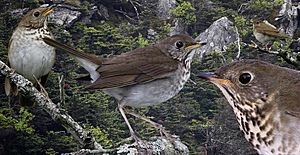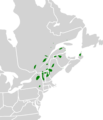Bicknell's thrush facts for kids
Quick facts for kids Bicknell's thrush |
|
|---|---|
 |
|
| Conservation status | |
| Scientific classification | |
| Genus: |
Catharus
|
| Species: |
bicknelli
|
| Synonyms | |
|
Catharus minimus bicknelli |
|
The Bicknell's thrush (Catharus bicknelli) is a medium-sized thrush. It measures about 17.5 cm (6.9 in) long and weighs around 28 g (0.99 oz). This bird is one of the rarest and most local breeders in North America. It lives on cool, high mountain tops covered with evergreen trees. It also likes forests that have been recently changed, like by logging.
The Bicknell's thrush looks and sounds a lot like the Gray-cheeked thrush (Catharus minimus). Even though they look similar, these two species live in very different places when they are raising their young. They also have small differences in their bodies and calls. The bird was named after Eugene Bicknell. He was an American amateur ornithologist (a scientist who studies birds). He first found this species on Slide Mountain in the Catskills in the late 1800s.
Contents
About the Bicknell's Thrush
The Bicknell's thrush is a bit smaller than other northern thrushes in the Catharus family. It is usually about 17 cm (6.7 in) long. Its weight is typically between 26 and 30 grams. Both male and female birds look the same and are about the same size. However, males tend to have slightly longer wings.
Adult birds have olive-brown or brownish feathers on their upper parts. This includes their head, neck, and back. Their tail has a reddish-brown tint. This color difference is less clear when their feathers are old. Their belly is off-white with gray on the sides. Their chest is off-white with a yellowish tint and dark spots. These spots fade towards the sides and lower chest. They have pink legs and a light gray ring around their eyes. Their cheeks are gray. The bottom part of their beak is yellow for about two-thirds of its length. The tip of the bottom beak and the entire top beak are blackish.
They are a little smaller than the very similar gray-cheeked thrush. But it is almost impossible to tell them apart just by looking. The gray-cheeked and Bicknell's thrushes are called a cryptic species pair. This means they look almost identical but are different species. They were once thought to be the same species. The song of the Bicknell's thrush is a mix of flute-like sounds. It ends on a higher note.
Bicknell's Thrush Family Tree
The Bicknell's thrush is part of the Turdidae family, which includes many types of thrushes. It belongs to the Catharus group of birds. There are twelve species in this group. Five of these species live in North America. The closest relative to the Bicknell's thrush is the Gray-cheeked Thrush. These two birds were once thought to be the same species. But DNA tests showed they became separate species about 1 million years ago.
Where Bicknell's Thrushes Live and Travel
The Bicknell's thrush breeds in scattered areas. These areas stretch from southeastern Quebec to Nova Scotia. They also live on high mountain "sky islands" in northern New England and New York state. It is the rarest and most private of the thrushes that breed in North America. It is also the only bird species that breeds only in the northeastern part of the continent.
When breeding, it is very picky about its home. It likes high-altitude evergreen forests that get strong winds and heavy ice. They usually nest at higher elevations, often above 915 m (3,002 ft). However, they also live in forests that are growing back after being cut down by the timber industry. So, their home is often a forest that has been disturbed. The trees there are usually small and stunted.
When they migrate, Bicknell's thrushes are less picky about where they live. Bicknell's and gray-cheeked thrushes, along with the veery, are a group of birds that travel long distances. These birds migrate to the West Indies and the Greater Antilles. About 90% of them spend winter in Hispaniola. During winter, they live in broadleaf forests at different heights. They generally prefer higher elevations.
Bicknell's Thrush Behavior
How Bicknell's Thrushes Communicate
Bicknell's thrushes sing mostly at dawn and dusk. The male bird usually sings, but sometimes females do too. Like all North American thrushes, their song sounds like a flute. It is high-pitched and lively. The song has four parts: “chook-chook, wee-o, wee-o, wee-o-ti-t-ter-ee”. Unlike the Gray-cheeked Thrush, the last part of their song stays at the same pitch or goes higher.
Their main call is a downward whistle, sometimes called the “Beer call” (“beer”). They also make a growling sound when they are alarmed (“crr-rr-rr”). Their flight call sounds like “cree-e-e”.
Raising Young Birds
Bicknell's thrushes have a unique way of mating. Females may mate with more than one male. This is called polygynandry. It is not known to happen in other thrushes. Up to four males might help with one nest. This includes bringing food for the baby birds. Females might choose to mate with more males when there is less food available. It is thought that pairs form after females arrive at the breeding site in late May.
The nest is usually a large cup made of twigs and moss. It is built close to the trunk of an evergreen tree. Nests are often at the base of horizontal branches, usually about 2 meters (6.5 feet) above the ground. The female builds the nest by herself. She lays three or four eggs in each clutch. The eggs hatch in about two weeks. The baby birds, called nestlings, grow very quickly. Both parents feed them. In just 12 days, they grow from tiny hatchlings to fully feathered birds the size of adults.
Bicknell's thrushes can get parasites like ticks, blowflies, and lice. The red squirrel is the main animal that eats their eggs and nestlings. Predators that hunt adult nesting birds include the sharp-shinned hawk, the long-tailed weasel, and the northern saw-whet owl. There are other animals that might attack nests or adult birds during breeding, migration, or in winter.
What Bicknell's Thrushes Eat
The thrush mainly eats insects. Beetles and ants are their favorite foods. They also start eating wild fruits in late summer, around mid-July. They continue to eat fruits during their migration and in their winter homes. In winter, they eat both insects and wild fruits.
They usually look for food on the forest floor. But they also catch flies in the air. They also pick insects off the leaves of trees, a method called gleaning. Birds eating fruits in winter often look for food higher in the trees than those eating insects. Bicknell's thrushes usually find food by pausing and looking around. They do this by hopping and taking short flights. Sometimes they scratch the ground for food, especially in their winter areas.
Protecting Bicknell's Thrushes
Dangers to Bicknell's Thrushes
The number of Bicknell's thrushes is going down in some parts of their limited home. This is because their habitat is being damaged. Scientists believe that pollution from industries is a main reason for the decline of the red spruce tree. This tree is very important for the thrush's home in the United States. Tiny bits of heavy metals in the air can also harm high-elevation forests in the northeastern United States.
Scientists also predict that carbon dioxide increases will greatly reduce balsam fir forests in the eastern United States. This could happen by the end of the century. If global temperatures rise and forests change a lot, the Bicknell's thrush's home could be seriously affected. Models show that the Bicknell's thrush could lose over 50% of its breeding habitat in the next 30 years. Also, building new recreation areas, cell towers, and windmills causes their habitat to break into smaller pieces and get worse.
Even though industrial forestry practices can be harmful, they might be changed to help save the Bicknell's thrush. More study is needed, but the bird seems to accept some forests that are growing back after being cut. This gives hope that humans might be able to create new homes for the Bicknell's thrush in the future.
Bicknell's thrushes have more mercury in their blood than other Catharus thrushes that live at lower elevations. Mercury levels go up a lot with altitude. It also builds up in the food chain. This might explain why mercury levels go down as the breeding season goes on and birds start eating more fruits. High mercury levels can make it harder for birds to have babies.
There is also a lot of worry about the damage to the Bicknell's thrush's winter homes. The natural forests in the Dominican Republic are under a lot of pressure. This comes from natural events like hurricanes. It also comes from changes due to farming, especially in low areas. The forests in Haiti have almost completely disappeared. In Cuba, most of the good habitat for these birds is only found in protected parks.
Helping Bicknell's Thrushes
Not many specific actions are being taken to help the Bicknell's thrush right now. However, the International Bicknell's Thrush Conservation Group (IBTCG) has made plans to protect the species. Near ski trails, keeping the edges of the forest sloped gradually helps. Also, leaving large forest "islands" between trails creates better homes for the thrush.
Another way to reduce disturbance is to limit changes to plants near mountain tops outside of the breeding season. In areas where buildings are put in good thrush habitat, it is suggested to replant trees to fix temporary changes. Putting up signs or barriers along trails to these buildings can also help reduce disturbance. Since forests that are growing back are good homes for this bird, making sure forests keep regrowing after clear-cuts helps the Bicknell's thrush. In their winter homes, planting trees on old farmland is a suggested way to protect this declining thrush.
Images for kids
- Bibliography on the International Bicknell's Thrush Conservation Group website
- Bicknell's thrush on Cornell Lab of Ornithology's All About Birds website
- Bicknell's thrush on Birds of North America website
- Bicknell's thrush on Audubon Field Guide website
- Photos of Bicknell's thrush at Visual Resources for Ornithology (VIREO) website
See also
 In Spanish: Zorzal de Bicknell para niños
In Spanish: Zorzal de Bicknell para niños




